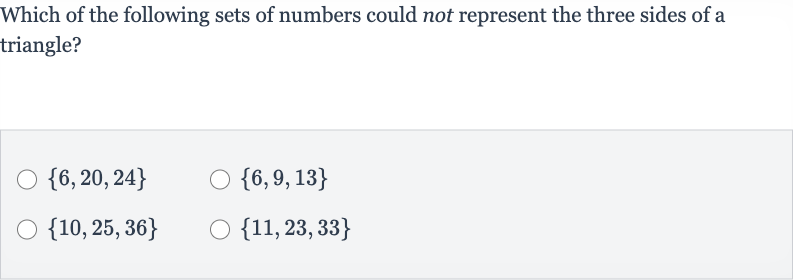Full solution
Q. Which of the following sets of numbers could not represent the three sides of a triangle?
- Triangle Inequality Theorem: To determine if a set of numbers can represent the sides of a triangle, we use the triangle inequality theorem. The theorem states that the sum of the lengths of any two sides of a triangle must be greater than the length of the third side. We will apply this theorem to each set of numbers.
- Set : First, we check the set . According to the triangle inequality theorem, we should have 6 + 20 > 24, 6 + 24 > 20, and 20 + 24 > 6. Let's check these inequalities:, which is greater than ., which is greater than ., which is greater than .All inequalities hold true, so this set could represent the sides of a triangle.
- Set : Next, we check the set . According to the triangle inequality theorem, we should have 6 + 9 > 13, 6 + 13 > 9, and 9 + 13 > 6. Let's check these inequalities:, which is greater than ., which is greater than ., which is greater than .All inequalities hold true, so this set could represent the sides of a triangle.
- Set : Now, we check the set . According to the triangle inequality theorem, we should have 10 + 25 > 36, 10 + 36 > 25, and 25 + 36 > 10. Let's check these inequalities:, which is not greater than . This inequality does not hold true.Therefore, this set cannot represent the sides of a triangle.
- Set : Finally, we check the set . According to the triangle inequality theorem, we should have 11 + 23 > 33, 11 + 33 > 23, and 23 + 33 > 11. Let's check these inequalities:, which is greater than ., which is greater than ., which is greater than .All inequalities hold true, so this set could represent the sides of a triangle.
More problems from Checkpoint: Rational and irrational numbers
QuestionGet tutor help
QuestionGet tutor help
QuestionGet tutor help
QuestionGet tutor help
QuestionGet tutor help
QuestionGet tutor help
QuestionGet tutor help

